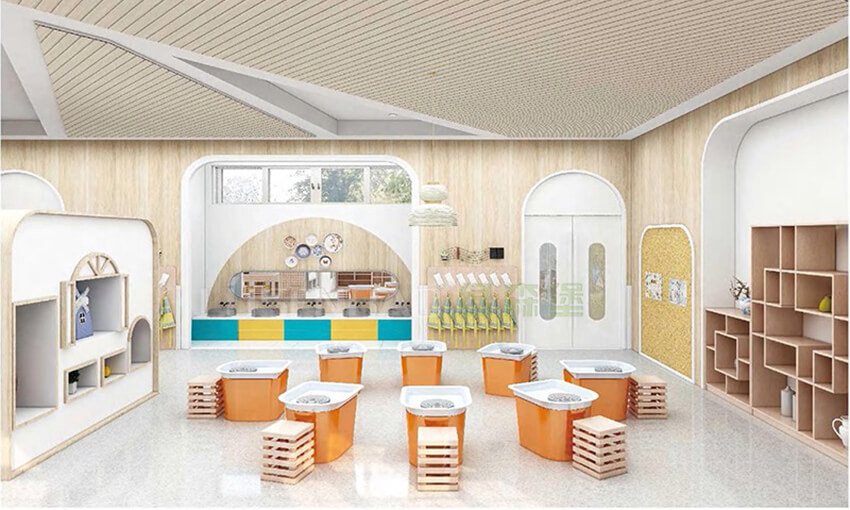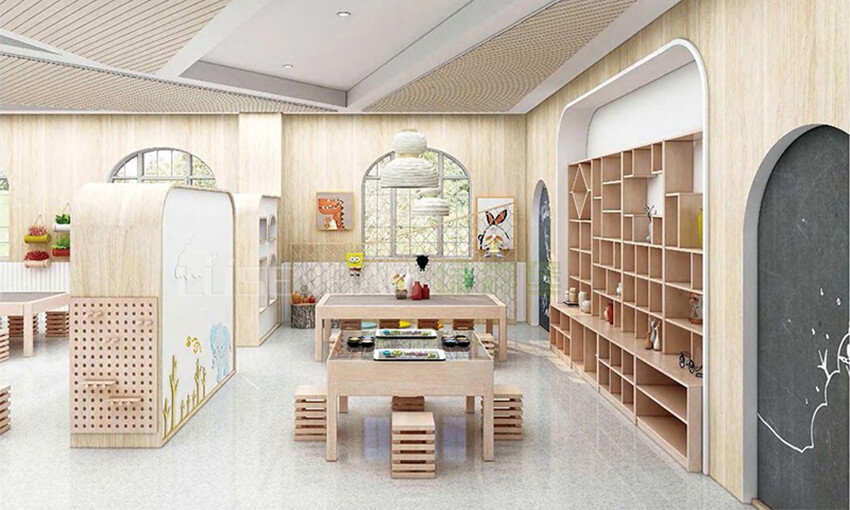Early childhood classroom furniture has become a new model of classroom decoration. The advantage of children play space design is that it can meet the individual needs of the kindergarten, and it is designed according to the characteristics of the teaching space. Customized kindergarten furniture must be from the perspective of children. For creation, designers need to use “childlike” kindergarten design ideas to capture every “childishness” and look at the surrounding world gently with pure eyes.
With the progress of the times, our living conditions are getting better and better. More and more parents hope that their children can learn in a superior environment and have a good development. Naturally, it starts with the choice of kindergarten. For those companies that run kindergartens, how to create a kindergarten that attracts parents has become a common topic of discussion. So today we will talk about early childhood classroom design ideas for kindergarten.
For kindergartens, it is necessary to have a pleasant space. How to create a comfortable, safe, healthy, caring, and childlike educational space under limited land conditions is a basic problem that designers need to face.


Children furniture sets and preschool wall painting designs are included throughout the case. Children’s growth environment should be an environment full of warm colors, soft lighting, bright colors, wide activity space, rich and not messy. In terms of decorative colors, similar color systems and several main colors are used. Daycare furniture colors can stimulate children’s vision, and irregular corridors stimulate children’s imagination. Children’s growth environment should be rich environment with dreamy scenes. Wall painting design for preschool is a supplement vigorous for children daily nutrition.
“Love and Fun” are customized for the whole house, with an open teaching concept, including three themes: able to breathe (green nature), future-oriented (exploration spirit), infinite possibilities (personality development), combined with the educational concept, the designer proposed “The concept of “home”, I hope that each space can form a concept of “home”, and I hope that children can establish a sense of belonging in the nursery. Each space is not only relatively independent in shape but also different in material, making each space more personalized and recognizable.
The fun of the whole house custom space design stimulates children’s interest in exploration, imagination, and creativity, and also puts forward more requirements for space design. In addition to the regular children’s living area, music room, activity area, reading area, art area, construction area, and other spaces to meet the basic teaching needs, the designer also set up more open teaching spaces.
And explore the possibility of translucent materials to create an atmosphere in the kindergarten educational space, so that it can reflect colorful rhythm in the sun, and inspire children to observe the outside space of the early childhood classroom from different perspectives. The interesting whole-house custom space brings novelty to children, encourages children to discover and explore, and creates a space that can stimulate children’s imagination. It embodies the life education concept of “stimulating children’s vitality and promoting children’s inner development”.
5 Fun Ideas to Engage Children in the Early Childhood Classroom
Creating a vibrant and engaging classroom environment for young children doesn’t have to be difficult. With a few creative ideas and some playful activities, you can create an exciting and stimulating learning space that will cultivate a love of learning in your students! Learn five fun ideas to get your early childhood classroom started.
Hands-on Science Experiments
Science experiments allow children to explore the world and learn in a creative way. Try some simple experiments that help kids observe different aspects of the natural world and connect with their environment. For example, place leaves of different colors in water for several hours then observe how the leaves changed color after being in the water. Engage children by helping them turn this experiment into a creative story or song!
Group Storytelling
Storytelling is a fun and powerful way to get children involved in the process of learning. Have the class come together and brainstorm different stories, then assign roles to the children so they can act out the stories together. This will help them practice their language skills, learn about teamwork, and use their imagination. As an added benefit, this activity helps build confidence and social skills as each child has an opportunity to contribute to the group.
Dramatic Play
Dramatic play is a great way to help children learn, create and practice real-life scenarios in a safe and entertaining way. You can provide props and costumes that revolve around different themes such as dressing up, acting out stories they have read together, or acting out other jobs or daily life activities. This encourages social interaction, imagination, cooperation, and creativity while allowing the children to engage with their peers in a meaningful way.
Creative Crafts
Creative craft activities provide a fun way to promote imagination and self-expression in the early childhood classroom. Try out projects like paper mache, drawing, clay sculpting, and painting as an engaging way to teach basic construction principles, the use of colors, shape recognition, and fine motor skills. You can also give children the opportunity to express themselves by having them create their own pieces of art or decorations for the walls that they may even incorporate into dramatic play scenarios.
Outdoor Play Activities
Outdoor play allows children to get fresh air and foster physical and emotional development. Try establishing an outdoor classroom with games like hopscotch, soccer, four-square, and Twister, as well as gardening activities for children to learn about nature and interact with their environment. You can also organize scavenger hunts around the playground or schoolyard, have students explore in teams for hidden things, and then bring what they’ve found back for further investigation and discussion.

